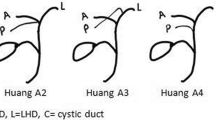Summary
Intraoperative cholangiograms were studied in 250 patients. Analysis of the data obtained led to the establishment of a protocol for intraoperative cholangiography aimed at identification of anatomical anomalies and variations. Diagnosis of the latter must be achieved in order to avoid possible intraoperative complications. The common hepatic duct was formed by the junction of the right and left hepatic ducts in 52% of the cases studied. Absence of convergence of the posterior and anterior rami of the right hepatic duct was found in 30% of cases. Anatomical variations of the right sectorial duct system were seen in 12% of cases. Conversely, variations of the left sectorial duct system were rarely seen (2% of cases). Careful examination of the intraoperative cholangiograms led us to suspect certain anatomical variations in close to 1% of cases. These variations included abnormal hepatocystic duct, which if undiagnosed could lead to choleperitoneum or inadvertent ligation of the right hepatic duct. An abnormal hepatocystic duct terminating on the gall bladder was found in one patient. Study of the origin of the common bile duct allowed us to define the mode of termination of the cystic duct (on the right margin of the common hepatic duct in 80% of cases) and to identify a short choledocus in 2% of cases. Finally, variations of the duodenal termination of the common bile duct were studied and reflux into the pancreatic duct was seen in 27% of cases. However, the pathological significance of such reflux was rarely found.
Résumé
L'étude de 250 documents permet de définir un protocole de lecture des cholangiographies peropératoires à la recherche d'anomalies ou de variations, dont la méconnaissance peut exposer à des complications per-opératoires. L'analyse du cholangiogramme intra-hépatique permet de retrouver une disposition modale dans 52% des cas. L'absence de convergence des canaux sectoriels, latéral et paramédian droits est notée dans 30% des cas. Les variations des canaux sectoriels droits sont retrouvées dans 12% des cas. A l'opposé, les variations du système canalaire gauche sont rares (2%). Dans près de 1% des cas, la lecture attentive du cholangiogramme permet de soupçonner certaines variations, tels les canaux cysto-hépatiques dont la méconnaissance expose à un cholépéritoine ou à la ligature d'un canal hépatique droit, à implantation vésiculaire (1 cas). L'étude du confluent biliaire inférieur précise le mode d'implantation du canal cystique (80% des cas sur le bord droit du canal hépatique commun) ainsi que l'éventualité d'un vrai cholédoque court (2% des cas). Enfin, deux aspects sont envisagés: les variations d'implantation terminale du cholédoque au niveau du duodénum et la constatation d'un reflux wirsungien noté dans 27% des cas. La signification pathologique d'un tel reflux est rarement établie.
Similar content being viewed by others
References
Albaret P, Chervalier JM, Cronier P, Enon B, Moreau P, Pillet J (1981) A propos des canaux hépatiques directement abouchés dans la voie biliaire accessoire. Ann Chir, 35: 88–92
Benoit G, Larrieu H (1979) Apport de la radiokinésimétrie dans l'interprétation du reflux wirsungien dans les pancréatites aiguës associées à une lithiase biliaire. Gastroentérol Clin Biol 3: 329–335
Bismuth H, Lazorthes F (1981) Les traumatismes opératoires de la voie biliaire principale. Monographie de l'AFC, 83e Congrès, Masson, Paris
Boutboul R, Letreut YP, Pau C, Rodde JM, Bricot R (1972) Les canaux cysto-hépatiques. Incidences chirurgicales et revue de la littérature. A propos de 10 cas opérés. J Chir 119: 325–333
Champetier J, Davin JL, Letoublon C, Laborde Y, Yver D, Cousset F (1982) Aberrant biliary ducts (vasa aberantia): surgical implications. Anat Clin 4: 137–145
Couinaud C (1957) Le foie. Etudes anatomiques et chirurgicales. Masson, Paris
Delmont J, Vedel JP, Allemano I (1980) Pancréatite aiguë et reflux bilio- et duodéno-pancréatique. Gastroentérol Clin Biol 4: 223–224
Delmont J (1979) Le sphincter d'Oddi. Anatomie traditionnelle et anatomie fonctionnelle. Gastroentérol Clin Biol 3: 157–165
Goor DA, Ebert PA (1972) Anomalies of the biliary tree: report of a repair of accessory bile duct and review of the literature. Arch Surg 104: 302–309
Guivarc'h M, Benhamida F (1976) Le cholédoque court ou à implantation haute. A propos d'une observation. J Chir 112: 237–252
Havard C (1970) Operative cholangiography. J Surg 57: 797–805
Juvara I, Dragomirescu C (1981) Ulcère duodénal et cholédoque court et reflux duodéno-cholédocien. Chirurgie 107: 585–591
Kantor H, Evans JA, Glenn F (1955) Cholangiography. Arch Surg 70: 237–252
Keller D, Gaylac F, Larrieu H (1982) Malposition de la vésicule biliaire située sous le lobe gauche du foie. A propos d'un cas. Ann Chir 36: 243–245
Koumare A (1977) Contribution à l'étude anatomo-radiologique per-opératoire des voies biliaires (à propos de 1 474 radios). Mémoire CES Radio-Anatomie, Poitiers, France
Kourias B (1979) Anomalies et variations des canaux biliaires extra-hépatiques. Leur intérêt chirurgical. J Chir 55: 393–422
Lataste J, Albou JC (1977) Le reflux dans le canal de Wirsung au cours de la radiomanométrie biliaire per-opératoire. A propos de 200 cas. J Chir 113: 3–14
Lataste J, Albou JC (1977) Le reflux dans le canal de Wirsung au cours de la radiomanométrie biliaire per-opératoire dans les pancréatites aiguës et chroniques. J Chir 113: 255–262
Longo OF, Mammana LA (1969) Canaux biliaires segmentaires aberrants et cholangiographie. Lyon Chir 65: 499–505
Mallet-Guy P, Guiria F (1957) Reflux wirsungien et pancréatites. Lyon Chir 53: 481–496
Michot F, Champault G, Patel JC (1979) A propos d'une anomalie rare des voies biliaires. Nouv Presse Med 8: 2687
Missen JB (1969) Aberrations of the biliary passages on the surface of the liver and gallbladder and in the gallbladder wall. Br J Surg 56: 427–431
Pannier M (1971) Le canal cystique. Etude anatomique et fonctionnelle. Thèse Med Nantes, France
Pillet J, Albaret P, Guntz M (1973) Considérations anatomochirurgicales des variations des voies biliaires pédiculaires. Arch Med Ouest 5: 423–436
Salembier Y (1977) Les cholédoques ≪courts-2>. Essai de systématisation. Nouv Presse Med 6: 2977–2984
Author information
Authors and Affiliations
Rights and permissions
About this article
Cite this article
Heloury, Y., Leborgne, J., Rogez, J.M. et al. Radiological anatomy of the bile ducts based on intraoperative investigation in 250 cases. Anat. Clin 7, 93–102 (1985). https://doi.org/10.1007/BF01655510
Issue Date:
DOI: https://doi.org/10.1007/BF01655510




